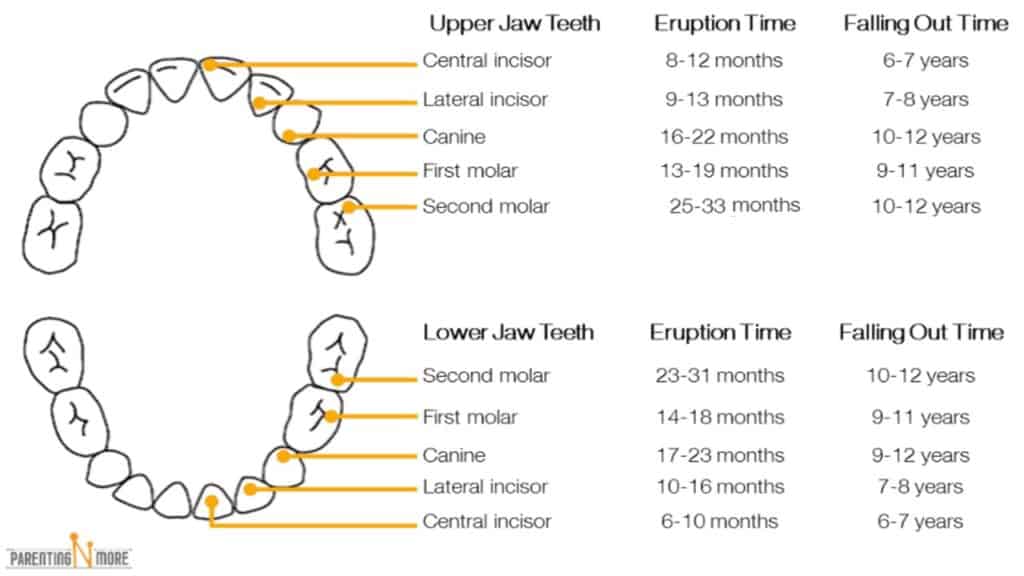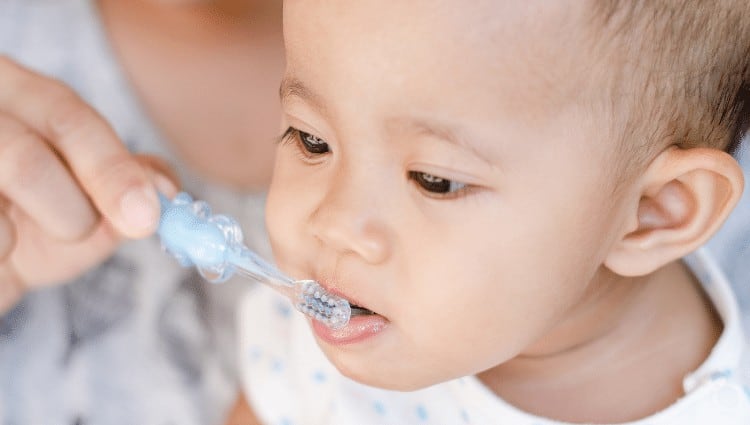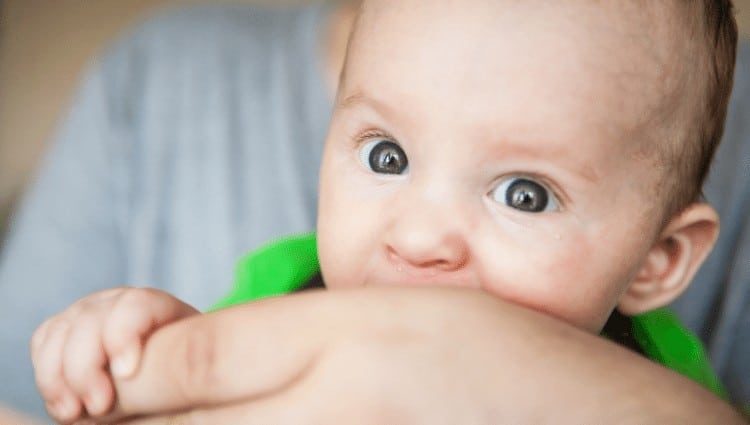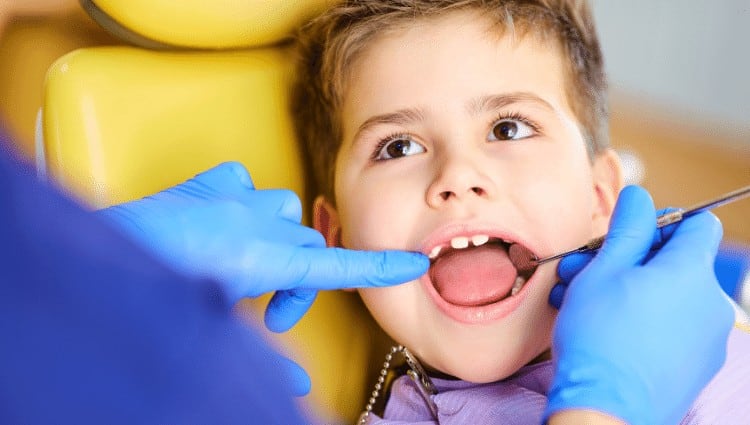Medically Reviewed by: Dr. Kedar Patnekar (MBBS, D.N.B, D.C.H, Specialist Pediatrician) Dubai, UAE.

Table of Contents - Baby Teeth Chart
Your baby’s pearly whites are a very important milestones. It is one of the earliest signs that your baby is growing. But waiting for the first tooth to erupt can make you and your baby restless and unnecessarily stressed.
Don’t worry, we are here to help you understand when to start looking for the teeth and which teeth will erupt first through our article on – ‘Baby Teeth Chart: sequence of eruption and Tips towards healthy baby dental care’.
The baby teeth chart or the baby tooth eruption chart that we have provided in this article will not only help you understand when the teeth are most likely to come, but also in what order in which they usually appear. To take a step further, we have also provided the usual age by when each tooth falls out as well in our baby teeth chart.
But this article is not just about the baby teeth chart, it also gives you complete information about a teething baby.
Baby teeth types
All teeth are different in terms of size, shape, and their placement in the jaws. These variations in the teeth help us chew, speak, and smile. Teeth help giving the face its shape and form. There are usually 20 baby teeth, which are also called primary teeth or deciduous teeth. These primary teeth make an appearance at about 6 months of age.
There are five different types of primary teeth:
- Central Incisors
- Lateral Incisors
- Canines
- First Molars
- Second Molars
Read this next
Baby teeth chart/ baby tooth eruption chart
All 20 primary teeth appear by the time the kids are 3 years old, and the first tooth appears starting from 5-6 months of age. Some children may even take longer, but there is no need to worry, but if you are still concerned you can contact your dentist or pediatrician.
The exact time of teeth eruption cannot be predicted, but the average time that most babies take for the teeth to come has been observed. The baby tooth eruption also is in a typical sequence. Along with the eruption time, the teeth tend to fall out also in a general sequence and around the same time in most kids.
The below baby teeth chart will help you understand and prepare beforehand for your baby’s teething requirements.

Please Note: The teething timeframes given in the baby teeth chart are approximate. Each child can be different and have delays in tooth eruption. Consult your doctor for any queries.
It can be observed from the above baby tooth eruption chart that the teeth could start erupting at around 5-6 months of age. The first two teeth that make an appearance are the lower jaw central incisors, which are the two teeth right in front at the bottom. The next teeth that appear are the upper jaw central and lateral incisors. These are the four teeth right in front and will come around the same time.
As seen from the baby teeth chart, the other teeth start erupting soon after. They start erupting in pairs, one on each side of the lower and upper jaw. This process will go on till all the 20 teeth, i.e. 10 in the upper and 10 in the lower jaw, have erupted. All the teeth have erupted by the time the child is 2½ to 3 years old. These 20 primary teeth remain in the mouth of the child till the permanent teeth don’t erupt, which starts happening at around 6 to 7 years of age.
But remember, if the first tooth of the baby was delayed in its eruption time, then the remaining teeth will also be delayed and will not follow the usual timeframes mentioned in the baby teeth chart.
Other than the information provided in the baby teeth chart, here are a few interesting facts about baby tooth eruption:
- Approximately four primary teeth will erupt in every 6 months. You can take this as a general rule.
- Girls tend to precede boys in terms of tooth eruption.
- Baby teeth or primary teeth are smaller in size compared to permanent teeth.
- Baby teeth are also whiter in color than the permanent teeth.
Baby teeth care
As seen in baby milk teeth chart, although baby teeth are only in the baby’s mouth for a short duration, they do play an important role.
- Baby teeth reserve space for the permanent teeth.
- They give the face its shape and form.
- They help in the development of clear speech.
- With the help of baby teeth, children gain proper nutrition. If the teeth are missing or are decayed, it can be painful while chewing, which can lead to children rejecting food that they need for their growth and development.
- Healthy baby teeth can give rise to healthy permanent teeth. If there is any decay and infection in the baby teeth, it can affect the permanent teeth as well.

So taking care of baby teeth is important. So let us look at how to take care of baby teeth to avoid cavities, tooth decay, and infections.
- Give your child healthy food with low-sugar foods and drinks. Say no to chocolates and candy as much as possible.
- Use spoons and utensils that are exclusively used for the baby. Sharing them can cause the bacteria from a sibling’s mouth to spread to the baby. This can cause tooth infection and decay.
- As soon as the baby gets the first tooth, schedule an appointment with the dentist. A baby should have their first dentist appointment before they turn a year old, even if the baby has no teeth by that time and then again at 3 years of age.
- Although many dentists and pediatrician originally recommend not brushing the baby’s teeth with fluoride toothpaste till they learn how to spit it out, which is around the time the turn 3 or 4 years old, the American Academy of Pediatrics (AAP) now recommends that you should start brushing your baby’s teeth with fluoride toothpaste as soon as the first teeth appears. They recommend to start with a size that is equivalent to a rice grain. Once the baby can start spitting the excess toothpaste out (at around 3 or 4 years old), you can start using a pea-sized amount.
- Brush the teeth twice a day.
- Avoid feeding the baby after brushing the teeth in the night.
- Never let the baby sleep with a milk bottle, this can lead to tooth decay.
- Even when the child starts brushing on their own, it is recommended that you apply the toothpaste on the toothbrush every day.
- Monitor and assist the child while brushing till they are 7 to 8 years old.
- The AAP also recommends that children should get a fluoride varnish done when they get their teeth. Getting the varnish done early can prevent the occurrence of tooth decay.
- Although cavities are the biggest problem for your baby’s teeth, children can also get gum disease. It happens when the gums holding the teeth get infected. Regular brushing can help avoid gum disease. If the gums start bleeding, don’t stop brushing. But if the gums are always bleeding or are swollen and sore, then go to the dentist immediately.
- Fluoride supplements are not needed before the baby is 6 months old, and even after that the baby only needs the supplements if the local water supply is not fluoridated or if the baby is only given bottled water to drink that contains no fluoride. Either way, consult your pediatrician before starting the baby on any kind of supplements.
- Fluoride is important because when the first tooth erupts, it is not fully mineralized. After eruption it is at a risk of tooth decay. Fluoride will help in strengthening the structure and enamel of the teeth and make it more resistant to damage and decay.
Baby teeth are also very fragile. Some ways through which you can protect them is as follows:
- Always use a car seat along with the seat belt for infants when you are travelling.
- Babies tend to chew on everything when their teeth make an appearance. Keep them from chewing on hard things that can crack their teeth.
- Kids tend to fall a lot when they start walking. Their balance is not the best at the beginning which can lead to falls quiet often. During these falls, the baby teeth can break, become loose, fall out or just crack. Consult your dentist if any of these things happen.
- Be careful and ensure their crib are well barricaded. They tend to toss and turn a lot. In case they are sleeping with you, ensure that you keep a pillow on your side if you are getting up at night. They tend to roll over the bed and fall down.
Baby teething signs – Baby tooth eruption chart
The baby teeth chart can help you understand approximately when your baby will start teething. Along with the baby teeth chart, there are a few signs of teething that you should keep an eye out for to help soothe them.

Key signs of teething may include:
- Extra fussiness
- Crying a lot more than usual
- Not eating properly
- The baby’s sleeping pattern can also change
- Swollen gums
- More drooling
If your baby shows two or more of the above signs around the time frames mentioned in the baby teeth chart, you can assume the baby is teething. This is also called teething syndrome.
You must have also observed that I did not mention fever as a sign of teething. This is a popular belief that the baby has a fever when they start teething, which is not true. If your baby is experiencing a fever, consult your pediatrician at the earliest.
Soothing techniques for a teething baby
Teething is a painful process for your baby. The baby’s pain can get to you as you may see your baby crankier than usual and you may feel helpless because you can’t do much to ease your baby’s pain. But here are some soothing techniques which can come handy during those difficult teething days.
- Use fingers to soothe. Use your fingers (clean off course) and gently apply pressure on their gums. Massaging their gums like this will help relieve the pain and will also distract them.

- Soothe using solid teething toys: Teething toys can also help relieve the pain. Never use the liquid-filled teething toys or rings because they can rupture while the baby is massaging the gums and the liquid could spill into the mouth and we don’t know what these liquids contain. It is better to avoid them altogether.
Using teething toys that are solid is recommended instead.
You can also place the toy in the freezer; kids feel additional relief when the toy is cold.
- Teething Biscuit’s: In case you are using teething biscuits, ensure that you are observing them constantly when they are eating the biscuit. Chunks from the biscuit can cause choking. Nutritionally these biscuits are not the best option as they contain sugar and salt in higher quantities.
- Soothing using finger foods: You could look at cleaning the thick part of the carrot and sharing large chunks for them to relive the chew bug. But be present always, carrots are soft, and the baby should not swallow the same by mistake. Would be good if you refrigerated the carrot for some time before giving it to the baby.
- Rub with a cold spoon: You can also rub and massage the gums with a cold spoon. Keep a couple of spoons in the freezer all the time. Once you have used the spoon on the baby’s gums, wash them thoroughly and pop it into the freezer again.
- Last resort – Medication: In case the pain is immense, and the child is not settling after trying all the soothing techniques, you can use some over-the-counter medication like acetaminophen to relieve the pain. But before you use any kind of medication, it is best that you consult your dentist or pediatrician. Tylenol has worked well on my babies to help them through those absolutely painful periods. However as mentioned, speak to your pediatrician first.
Here are the things that you should not do while trying to soothe the baby:
- Many doctor strongly advise against using teething gels. These gels contain benzocaine that numbs the gum so that the child will not feel pain. The same component, i.e. benzocaine, has been liked to some serious side-effects in young children. It is just best to avoid all teething gels as the risk of ingestion will be high.
- Just like teething gels, teething tablets also contain benzocaine and another plant poison called belladonna. Both benzocaine and belladonna numb the child’s pain, but the FDA has identified potential side effects of these components and has issued warnings against the use of both of them.
- Teething toys are a good option but not teething necklaces. When you place the necklace around the child’s neck, it can lead to strangulation. The beaded necklace is also a choking hazard. No studies or research has proven the effectiveness of these necklaces. It is best not to use them.
Note the timeframe of teeth eruption from the baby teeth chart so that you can stay prepared to soothe your baby when they start teething.
Permanent teeth
When the child reaches the age of 6 or 7 years, the first permanent teeth will start coming. These teeth are known as the first molars or the six-year molars.
These molars will appear behind the second molars of the primary teeth. They do not replace any of the baby teeth.
Around the same age that the first permanent teeth make an appearance, the child’s primary teeth will also start falling out one after the other over time. Children will eventually lose all the primary teeth and be replaced by permanent teeth.

The child can be around 12 years when they have lost all primary teeth.
If the tooth is loose and if the child wriggles and plays with it, it’s completely okay. But forcefully pulling the tooth out is not okay. The tooth will fall out on its own when the time is right. Forcefully pulling it out can lead to bleeding gums and the damage can affect the permanent teeth as well.
By the time the child is 4 years old, the facial bones and structure, including the jaw, start growing and developing. This growth can create space or gaps between the primary teeth. There is no reason to be concerned about these gaps. This process is completely natural and also necessary to create space for the larger permanent teeth.
During the time when the child is between 6 to 12 years old, there will be a mixture of both the primary and permanent teeth inside the mouth.
Even though by age 12 almost all primary teeth have fallen out, but all 32 permanent teeth erupt by the age of 21.
Final thoughts – Baby tooth eruption chart
Teething can be a tough time for parents, but it is also necessary for a growing baby. Getting into a dental care routine early on will help the child keep the teeth healthy.
Visiting a pediatric dentist is also a good idea as soon as you observe the first tooth eruption or before the baby’s first birthday, whichever comes first.
The AAP also recommends that the children should visit a pediatric dentist as soon as they get their first tooth. The dentist will ensure that all teeth are developing normally without any dental problems. Following their advice regarding dental care and hygiene will further help protect your baby’s pearly whites.
Hope our article on Baby teeth chart / Baby tooth eruption chart helps easing your anxieties related to your babys’ tooth eruption. It will give a fair idea when to expect tooth eruption along with signs and a few tips to soothe your baby.
Keep a track of the teeth eruption time shown in the baby teeth chart to help you monitor your baby’s progress. Don’t worry if there are a few delays in eruption of their tooth. Its normal. Bear in mind every child has its own growth pattern, similarly their tooth eruption could also be as per their own rhythm.
And last but not the least, let those pearly whites shine through your baby’s beautiful smile. It just means they are ready for selfies.
Happy Teething!



